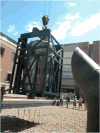Biomolecular NMR: Past and future
- PMID: 28495511
- PMCID: PMC5701516
- DOI: 10.1016/j.abb.2017.05.003
Biomolecular NMR: Past and future
Abstract
The editors of this special volume suggested this topic, presumably because of the perspective lent by our combined >90-year association with biomolecular NMR. What follows is our personal experience with the evolution of the field, which we hope will illustrate the trajectory of change over the years. As for the future, one can confidently predict that it will involve unexpected advances. Our narrative is colored by our experience in using the NMR Facility for Biomedical Studies at Carnegie-Mellon University (Pittsburgh) and in developing similar facilities at Purdue (1977-1984) and the University of Wisconsin-Madison (1984-). We have enjoyed developing NMR technology and making it available to collaborators and users of these facilities. Our group's association with the Biological Magnetic Resonance data Bank (BMRB) and with the Worldwide Protein Data Bank (wwPDB) has also been rewarding. Of course, many groups contributed to the early growth and development of biomolecular NMR, and our brief personal account certainly omits many important milestones.
Keywords: Biomolecular NMR history; Computational approaches; NMR instrumentation; Pulse sequence development; Sample preparation and labeling.
Copyright © 2017 Elsevier Inc. All rights reserved.
Figures









Similar articles
-
A special "JMR Perspectives" issue: foresights in biomolecular solution-state NMR spectroscopy - from spin gymnastics to structure and dynamics.J Magn Reson. 2014 Apr;241:1-2. doi: 10.1016/j.jmr.2014.01.010. J Magn Reson. 2014. PMID: 24656075 No abstract available.
-
An introduction to the special issue on biomolecular NMR.Arch Biochem Biophys. 2017 Aug 15;628:1-2. doi: 10.1016/j.abb.2017.06.020. Epub 2017 Jun 27. Arch Biochem Biophys. 2017. PMID: 28666741 No abstract available.
-
BioMagResBank (BMRB) as a partner in the Worldwide Protein Data Bank (wwPDB): new policies affecting biomolecular NMR depositions.J Biomol NMR. 2008 Mar;40(3):153-5. doi: 10.1007/s10858-008-9221-y. Epub 2008 Feb 21. J Biomol NMR. 2008. PMID: 18288446 Free PMC article.
-
Protein Data Bank (PDB): The Single Global Macromolecular Structure Archive.Methods Mol Biol. 2017;1607:627-641. doi: 10.1007/978-1-4939-7000-1_26. Methods Mol Biol. 2017. PMID: 28573592 Free PMC article. Review.
-
The quiet renaissance of protein nuclear magnetic resonance.Biochemistry. 2013 Feb 26;52(8):1303-20. doi: 10.1021/bi4000436. Epub 2013 Feb 12. Biochemistry. 2013. PMID: 23368985 Free PMC article. Review.
References
-
- Allerhand A, Childers RF, Oldfield E. Natural-abundance carbon-13 nuclear magnetic resonance studies in 20-mm sample tubes. Observation of numerous single-carbon resonances of hen egg-white lysozyme. Biochemistry. 1973;12:1335–1341. - PubMed
-
- Assadi-Porter FM, Abildgaard F, Blad H, Markley JL. Correlation of the sweetness of variants of the protein brazzein with patterns of hydrogen bonds detected by NMR spectroscopy. J Biol Chem. 2003;278:31331–31339. - PubMed
-
- Baillargeon MW, Laskowski M, Jr, Neves DE, Porubcan MA, Santini RE, Markley JL. Soybean trypsin inhibitor (kunitz) and its complex with trypsin. Carbon-13 nuclear magnetic resonance studies of the reactive site arginine. Biochemistry. 1980;19:5703. - PubMed
-
- Bax A. Two-dimensional Nuclear Magnetic Resonance in Liquids, Delft University Press, Delft. 1982
Publication types
MeSH terms
Grants and funding
LinkOut - more resources
Full Text Sources
Other Literature Sources
Research Materials
Miscellaneous

